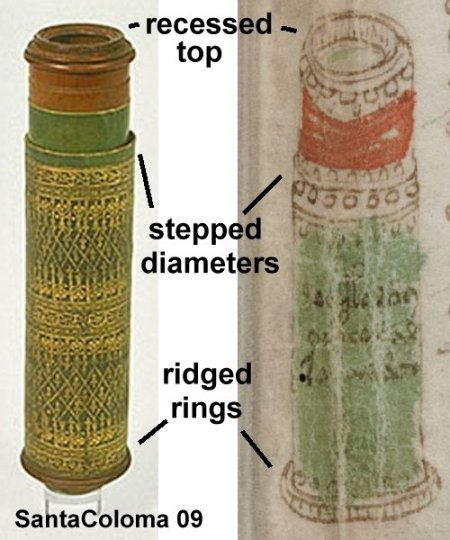It has been said that the Voynich theories I have developed and researched are only about the microscope comparisons, and without them, there is nothing left. This is very inaccurate, as there are many features of the Voynich, outside of the cylinders, which indicate to me the possibility that it was created in the time frame I am working in, and by the people I suspect.
But it is true that the optical comparisons are the seed of the ideas which came later. When I first looked over the Voynich, I was struck at the similarity between certain cylinders in it, and early microscopes. I was very surprised that this was not generally assumed, they looked so much alike. In several years of research, I only found one person… Chris Parry… who openly mused on this on the VMS-net list in 2003. Berj N. Ensanian later told me that he had long noted the similarities between the cylinders and the microscope of Robert Hooke.
Even Newbold, (of the well known failed theories and translations) who believed that Roger Bacon wrote the Voynich, and who he believed used a powerful microscope to do so, did not make a connection between the cylinders and the instruments. Newbold called them “jars”.
I personally think the similarities between the 17th century Italian microscope, and this Voynich cylinder, are striking. Many of the tubes have optical features, and I have made a page of many of them, here. A list of some of the features of early optics, which I feel may be represented in Voynich cylinders:
1 ) Multiple lenses
2 ) Multiple, sliding tubes
3 ) Covered with colored vellum (often red and green)
4 ) Decorated along edges with repeating, gilt embossing
5 ) Recessed lenses
6 ) Lenses with green and blue hues (nature of the glass used)
Elements also found in Voynich tubes which are described just after my time frame, possibly relating to Drebbel’s 1619 to 1624 devices:
7 ) Supported on brass legs, shaped like dolphins
And elements found on other, later, 17th and 18th century microscopes:
8 ) Decorative finial lens caps
9 ) Knurling of rings for easier adjusting and assembly/disassembly
It was pointed out by Keith Body that Egyptian perfume jars are very similar to some Voynich cylinders, and I agree:
For the generally assumed “jar” identification, then, I would agree that some of the Voynich tubes may be just that. However I do not think that the 15th and 16th century apothecary and albarello jars are good comparisons… they do not compare as well as optics, in my opinion. Even for the bizarre cylinders, such as the iconic one shown below, I feel optics are just a better match than jars or containers… or perpetual candles, soap dispensers, or others which have been suggested. Next to the f88 cylinder I show it in CAD, covered with tooled Moroccan leather, as an optical device would be. I think it is a good match to to the color and tone of the Voynich illustration. As for the color of my supposed “lens”, and the knurling marks, those are in the “original”.
The objections to my comparisons are many, and I will address them here in the future, as I have in the past on the VMS-net list. They are in part, that I use later optical devices for comparisons to a document which I state was made between 1610 and 1620. Also, that there is little or no evidence for microscopes before about 1619. And there are others, all of which I will address in future posts. Richard SantaColoma





Berj wrote me, “Thanks for the mention. However you give me too much credit I think: as I mentioned a while back on the the list, upon first hitting on Hooke and his Micrographia microscope illustration, I definitely immediately compared his Micrographia microscope to the VMS pharma cylinders to see how they compared, in the vein of being in the habit of trying not to overlook any possibilities – but I thought well, there is some similarity, but nothing I could clinch, at least to convince myself, and I went no further. Crucially, I did not research period microscopes other than Hooke’s and compare them. I was then subsequently re-interested in the idea that the VMS author had microscopes in mind with some of the pharma cylinders/tubes, at least unconsciously when he was drawing the pharma objects, when I read your very detailed work – in particular your pointing out similarities of knurling and the colored glass eyelenses.”
Thank you for the info, Berj.
Pingback: Optical Timeline « The Voynich-New Atlantis Theory
Assuming a microscope, if the blue cones were stylised light-paths, that would make the ring between them the stage. From bottom to top you would have light-source (obviously a burner of some kind on its little legs), stage and optical bench, with eyepiece at the top.
I’m commenting on entries 2 years old. Sorry about the necromancy.
Oh my god I hope it’s not “necromancy”! The blog isn’t dead yet, that is! Sleeping sometimes, maybe. As for your points on a representation of light paths (good idea), of course we both can’t know, but I like your use of “stylized”. Whatever the Voynich is, anything recognizable in it probably is “stylized”… that is a good way to put it. Thanks for the comments and interest.
Perhaps they are drawings of microscopes made from Egyptian perfume jars?
Pingback: First Entry in the Truth Wrestling Federation’s Death Match! | Thoughts about the Voynich Manuscript
Pingback: The Modern Forgery Hypothesis | The Voynich-New Atlantis Theory
Pingback: I Do “Listen to the Experts”. Do YOU? |